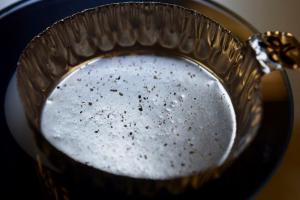For more than two decades, Jonathan Cohen has studied the tiniest marine life found in bays and oceans around the world.
Throughout those years, the University of Delaware assistant professor said, he has often found something unnatural tagging along in each sample of bay water: Plastics.
Finding plastic fragments, clothing fibers and microbeads from body scrubs under his microscope made Cohen question how common the tiny microplastics are in Delaware waterways.
“The Delaware Bay is sort of an unknown world in terms of microplastics,” he said. “We want to contribute to the larger conversation that people are having across the world about plastics.”
Marine debris is making headlines around the world, particularly with more attention being paid to the Great Pacific Garbage Patch. Regional studies, including marine debris research in the Chesapeake Bay, have found microplastics are widespread and may be hurting marine animals' reproductive systems and overall health when plastic replaces their regular food sources.
When an animal ingests plastic instead of plankton, that organism is not getting the nutrients it needs, which can affect its size, growth and ability to reproduce. Cohen said some scientists also have suggested there might be toxic compounds that are absorbed when animals ingest microplastics, which could then move through the food web.
“We know there's a capability for problems in the food web,” Cohen said. “The question is, do we actually see it?”
To begin answering that question as it relates to the Delaware Bay, scientists first need to find out where plastics are showing up and develop uniform methods for studying contaminants.
“There have been and will continue to be plastics,” Cohen said. “What we're doing now is really trying to assess with data how big of an issue it is. I think we don't know. That doesn't mean we can't keep our use of plastics and treatment of waste plastics in a way that would reduce the problem.”
Avoiding products that contain microbeads, promoting proper recycling practices and washing synthetic clothing in filter bags are ways the average person can reduce their input of microplastics into local waterways, he said.
“The consumers have a role, too, in being conscious of how waste is handled and disposed of,” he said. “It's important to realize the way we use and dispose of plastics can have impacts on what's found in the water.”
Cohen is undertaking the first comprehensive look at the distribution of microplastics in the Delaware Bay, thanks to research funding provided by Delaware Sea Grant.
“My interest has stemmed from seeing these things over time and recognizing a global interest in them,” he said. “The organisms we tend to work the most on – copepods, little shrimp, crab larvae – that's the size of their food. So there's a need to investigate potential ecological impacts.”
But first, Cohen said, scientists need to find out when and where microplastics are found. Once that is known, scientists can explore how the marine life in microplastic-riddled water is affected.
Cohen began surveying microplastics smaller than 5 millimeters - in some cases, as small as 0.3 millimeters - in the Delaware Bay last fall, focusing on 16 survey stations used by researchers for other marine projects as far north as the Cherry Island Landfill in Wilmington along the Christina River. Simultaneously, the Department of Natural Resources and Environmental Control is surveying microplastics found in the sand along three Delaware Bay beaches.
“We have to know more information, but at the heart of everything, we know plastics are a manmade material, so they're not supposed to be there,” said Kari St. Laurent, research coordinator and environmental scientist at DNREC's Delaware National Estuarine Research Reserve. “The question is, how big of a problem is it?”
For Cohen's study, researchers use a fine net to collect samples from the top of the water at each of the stations. Samples also are collected from deeper water off Bowers Beach looking for fragments that are too heavy to float on the surface, including particles already eaten by organisms and stuck in fecal pellets.
The goal of the study is to find out if there are hot spots of microplastics, and whether microplastics increase in certain areas at different times of the year, Cohen explained.
“We're just starting to explore this,” he said, adding that future studies will look at the movement of water in the Delaware Bay to possibly pinpoint where plastics originate and then determine what effect they have on the marine ecosystem.
“Our suspicion is most of the microplastics are coming from upstream,” Cohen said. The data collected so far have shown the most plastics are found at the more urbanized Cherry Island Landfill site, while the pollutants are less concentrated farther down the bay. He said researchers also plan to partner with the Kent County Wastewater Treatment Plant to find out how well the system filters microplastics such as fleece fibers and microbeads found in cosmetics and skin care products.
“Plastics stick around for a really long time,” St. Laurent said. “Water bottles and plastic bags slowly break down into these microplastics. That's a hard issue to convey because you can't really see it.”
In 2015, President Barack Obama recognized the potential dangers of microbeads in coastal systems and signed the Microbead-Free Waters Act, which requires companies to stop using plastic exfoliants in products such as toothpaste, cosmetics and face wash.
But for local regulations or laws to be enacted to reduce plastics entering Delaware's waters, scientists need to have data proving they're a problem. It's just too soon to tell if that's actually the case, Cohen said. He said he hopes to provide a report later this year on the study findings, and secure additional funding to extend the research. To learn more about the current project, go to www.underthescope.udel.edu/microplastics.
“I think the average person needs to know there are microplastics in our waterways,” Cohen said. “It's unclear how big of an impact that plays on the crabs they eat, the fish they collect and eat, but it's something that we should learn more about because the impacts at this point are unknown.”














.jpg)









































